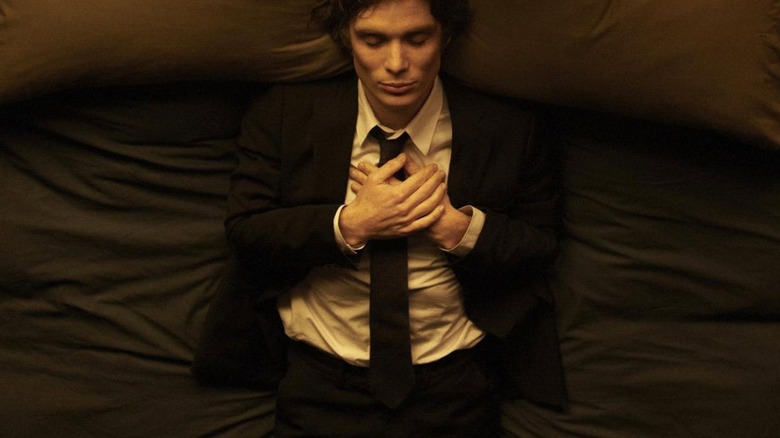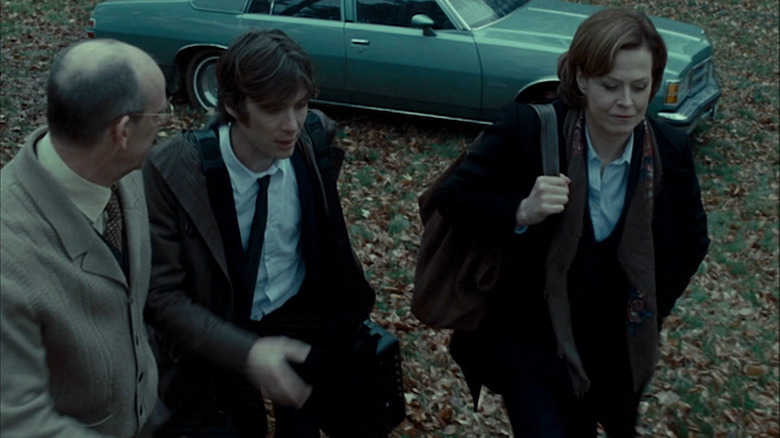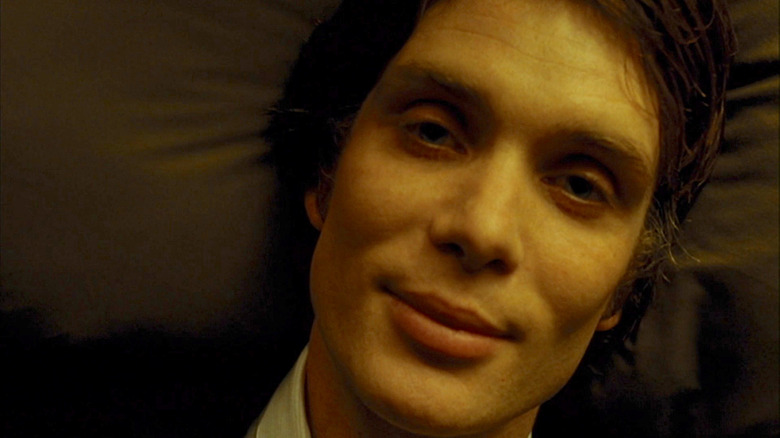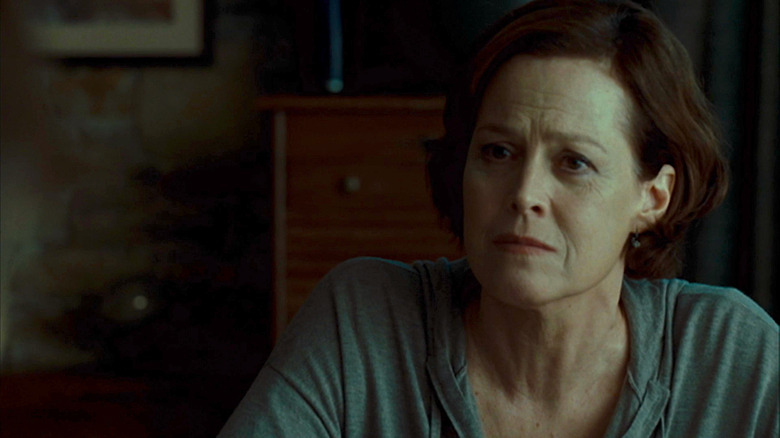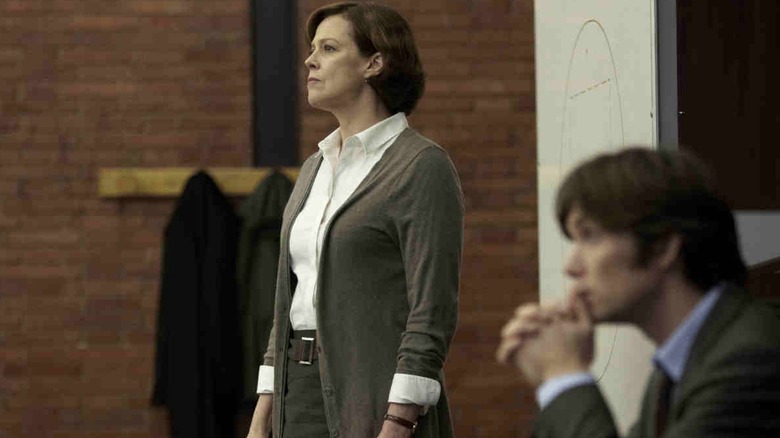The Ending Of Red Lights Explained
"Red Lights" is a 2012 horror/thriller that asks an intriguing question: What happens when two scientists known for debunking frauds can't find a way to debunk a famous psychic? It's a strong hook, and "Red Lights" serves it up with an almost "X-Files" energy. The movie's themes of belief and skepticism are dealt with in gorgeously staged scenes, the cast is stellar, and the Barcelona and Toronto locations are absolutely glorious — but the ending of "Red Lights" is completely confounding.
Dr. Matheson (Sigourney Weaver) and Dr. Buckley (Cillian Murphy) try to take down a silver-tongued psychic appropriately named Simon Silver (Robert De Niro), but the journey just might take them — and bewildered viewers — down instead. The "Red Lights" of the title are a phenomenon Matheson describes as "discordant notes" — inconsistencies in environment and behavior that scientists search for to indicate something is off with a paranormal experience. Usually, they're indicators that fraud is afoot. You see many examples in the film, but no amount of red lights in "Red Lights" indicate what's coming at the movie's end.
We'll try to assess this love-it-or-hate-it conclusion with the same scientific rigor and emotional intensity as the movie's scientists. Open up this spoiler-heavy file, bend the nearest spoon with your mind, and read on for the ending of "Red Lights" explained.
What you need to remember about the plot of Red Lights
Dr. Margaret Matheson is a no-nonsense psychology professor and foe to fraud psychics. Her devoted assistant is oddball Dr. Thomas Buckley. Together, they expose those using "special powers" to scam the vulnerable — then teach college students about the methods to the charlatans' madness. But when famous blind psychic Simon Silver announces he's coming out of a long retirement, the movie stops being a strange, engaging slice of scientist life — and starts getting real.
Silver has not made a public appearance since he (maybe) killed a major detractor with his mind. It's revealed that the spoon-bending super-psychic reached David Blaine-esque fame in the '60s, but his was career was cut short when a detractor died of a heart attack at one of Silver's shows. Buckley is itchy to disprove him, but Matheson warns Buckley to stay away. Silver is a con man of the highest order — even if she can't prove it.
Later, when Matheson also dies of a heart attack after a stressful encounter with Silver, the heartbroken Buckley's desire to debunk him becomes an all-consuming obsession. Buckley will stop at nothing to prove the sinister Silver is a fake, even if it means endangering his own life, the life of his science student girlfriend, or the lives of several small birds. Silver attacks Buckley via seemingly psychic strikes, not to mention a physical goon sent to beat Buckley down. Buckley survives it all to discover the truth about Silver — and himself.
What you need to remember about the world of Red Lights
The world of "Red Lights" is as rich and heightened as its performances. The movie posits a world so full of theatrical psychics claiming they can "cure" disease or see the "truth" that Dr. Matheson has a standing ticket in a specially-outfitted box at the local opera house so she and her debunking team can best catch scammers in the act. She even has special equipment installed in said box seats to pull sting operations on ESP bandits.
Every news team in the world of the movie knows psychic top dog Simon Silver on sight. Most man-on-the-street interviewees also have a working knowledge of his backstory and can cite some of his greatest psychic hits at the drop of a hat, in soundbite form. Additionally, major scientific studies are sometimes given the same pop culture pomp and circumstance as a hotly anticipated Taylor Swift re-recording.
Regardless of the sheer popularity of psychics in the world of "Red Lights," the science department at the local university that often investigates the fact and fiction behind these phenomena has no budget. Still, Matheson and Buckley are constantly traveling for cases. The TL, DR here: The world of "Red Lights" is a world of intense focus and extreme contradiction — which very much comes into play in the film's ending.
What happened at the end of Red Lights?
Buckley sneaks into Silver's secret black-market psychic advice apartment. Buckley doesn't speak, so the blind Silver shouldn't have any idea it's Buckley with him — but Silver still delivers a chilling monologue to scare Buckley away. It doesn't. When Dr. Shackleton (Toby Jones) asks Buckley to review scientific testing footage of Silver, Buckley demands student Ben (Craig Roberts) stay at the lab to review the tapes. If they can't prove Silver's a fraud by that night, Silver will announce Shackleton's findings at the night's big show — and prove to the world he is the real deal.
Buckley goes to the show to await Ben's news. But while he prowls around in all his emo scientist glory, he is stalked by one of Silver's goons. Buckley gets badly beaten in the bathroom. Meanwhile, his oft-ignored girlfriend Sally (Elizabeth Olsen) joins Ben. Sally spots the "red lights" in Silver's tapes — he and his testing partner are using an elaborate code to communicate the test answers to each other, making Silver appear psychic — and revealing he's not actually blind.
A very bloody Buckley confronts Silver with this info in front of a shocked theater crowd. Even though Silver holds strong and the theater lights explode, Buckley proves Silver's fraudulence by throwing the "blind" man a coin — which he catches. Buckley confesses and demonstrates his own truth — that he has actually been a true psychic all along. Buckley has powers, but denied himself until now.
What happened to Buckley at the end of Red Lights?
"Red Lights" is a slow-burn thriller until its rapid-fire ending. Buckley's big psychic reveal is blink-and-you'll miss it — or really, shield-your-eyes-from-exploding-lights-and-you'll miss it. So let's break it down. Buckley goes hard at Silver in the final scenes, while also going hard at himself. Buckley admits that he has psychic powers, but hid them from Matheson and others while he searched for someone else like him.
The scene shows Buckley's heartache at not finding a fellow psychic in Silver, Silver's true scam-artist nature, and Buckley's disappointment in himself for both denying his own abilities, and denying Matheson proof that some miracles do exist. Buckley's monologue is scored by a montage of moments from earlier in the film that viewers would have attributed to mystery, or worse — Silver's "powers." Dead birds, bent spoons, electrical explosions — Buckley reveals that he was the cause behind them all along.
Buckley hugs Sally after this big reveal, reuniting with her in a show of finally accepting himself and opening up to someone else. To make up for the truth he kept from Matheson, Buckley and Sally go to the hospital, where Buckley takes Matheson's long-vegetative son off of life support. This isn't a stone-cold killer move, but one to honor Matheson, and the tiny seed of hope she had that there was something "else." By the end of "Red Lights," Buckley is making some sort of peace with himself and his powers.
What does the end of the Red Lights mean?
The emotional power of the end of "Red Lights" is undeniable — but the action might be a bit indecipherable. Buckley's "actually here are all the times I was psychic" montage is beautiful, but jarring. Why did he bend Matheson's coffee spoon when they were on the phone? Why did he blow up the box at Silver's first show? Why did he kill so many birds with his mind?
While these questions can be considered logical plot holes, they're also emotional evidence of the destruction we wreak on ourselves and others when we refuse to live our authentic (psychic/telekinetic) lives. For Buckley, the end of "Red Lights" is a moment of revelation, release, and acceptance. He has been searching for someone "like" him his whole life, and almost found it in Silver — but by debunking this fraud, he validates himself, and finally stops denying his own nature.
Buckley can (and has) broken a bunch of stuff with his mind. He has tried to prove, using science, that he really can't exist (Matheson's logic never allowed for the real deal, the genuine miracle). But now, bloody and reborn, Buckley admits who he is in front of Silver and the world, finally accepting that there's no point not being all he can be. It leaves viewers with a sense of wonder about what positive shape his powers might take now that he's allowing himself to live his truth, rather than hide it.
Is Simon Silver really a fraud?
Silver is clearly motivated by money, but is he also driven by more mysterious forces? He's a super-scammer with extreme intelligence (what up, character twin to his "Heat" role) — but is there anything more mystical to him than meets the eye? Or is he proof positive that Matheson is right and smart people get taken in all the time?
Even though viewers know Silver has been scamming at least a little bit when Sally discovers his watch-hands testing trick, audiences don't know for sure until the final moments that Silver doesn't possess supernatural powers. In fact, the final confrontation relies on the spooky, dangerous connection that is felt throughout the movie between Silver and Buckley. The men seem to be two sides of the same coin — Silver playing up his false powers of persuasion, intimidation, and illusion, while Buckley shows great, but uncontrolled, genuine supernatural powers.
Though it isn't directly addressed in the movie, the connection between Silver and Buckley is so strong (and toxic) that it speaks to something significant shared between the two men. They also clearly have a deeper history with Matheson than the movie ever fully explores. Even if Silver isn't a full psychic, one gets the sense that he is still preternaturally gifted — he did bend that water — and that he is what Buckley could end up becoming if Buckley never accepted himself, or simply used his powers for personal gain alone.
What is the meaning of those final moments?
Buckley's relationship with Matheson is the rapidly beating heart of "Red Lights." When Matheson dies, Buckley is thrown into a tailspin of self-loathing, and ultimately self-discovery. But his ending monologue doesn't do much to explain how exactly he would gain power of attorney over her vegetative son's healthcare decisions. The movie's closing monologue and montage remind viewers of how attuned Buckley was to his mentor and mother figure — and, on a repeat viewing, that Buckley would do anything to continue learning from Matheson.
Those final scenes also serve to remind viewers that, for all of her skeptic Dana Scully-like tendencies, what Matheson really wanted to do was believe. Matheson told Buckley that, after her young son fell into a coma, she kept him on life support because she couldn't trust that there was anything else for him after this life. As she puts it, "When I hear the drumming of hooves, I don't think unicorns, I think horses." Well, with thinking like that, one can imagine a unicorn might do everything in his power to hide his horn from her.
After everything that happens after her death, however, Buckley finally feels free to share his truth with Matheson, by way of setting her son "free" into whatever afterlife might exist. It is his way of honoring Matheson's secret wish, as well as his way of continuing their close relationship by showing her his unicorn side, even if it was far too late for her to see it.
What is Red Lights really about?
"Red Lights" is about the danger — and hope — of belief. The film paints wanting to believe in rational explanations to life's mysteries with the same brush as wanting to believe in psychics having all the answers. Matheson is honest with Buckley about her skepticism and loss of belief in life beyond her scientific understanding. She also admits to Buckley that Silver's performance during a talk show they were on years ago made her doubt her beliefs about both science and her son. That experience rocked Matheson to her core, and in turn, fuels Buckley's denial of himself.
Matheson was so rational, so controlled, and so thorough in her investigations that she had stopped looking for the "red lights" in her own biases against miracles. Though she taught Buckley so many helpful things, she also taught him that there are only two kinds of people with "powers" — those who believe their own lies, and those who think others will believe their lies. Buckley internalized Matheson's teachings and clung to the shame and destruction of doubt, rather than the curious side of it — all the way up until the end of the film.
The ending of "Red Lights" shows that in order to truly be who we are, we must pursue answers to what we don't understand, as well as accept that there will by mysteries we'll never understand — and among those mysteries may be our very selves.
What could the ending of Red Lights mean for a possible franchise?
While it doesn't seem likely that a sequel to "Red Lights" will happen so long after its initial release, the movie leaves more than a few loose story threads to follow. Plus, who wouldn't want a fresh team up of Cillian Murphy, Sigourney Weaver, Robert De Niro, and Elizabeth Olsen? If the "Indiana Jones" can go decades between movies, why can't "Red Lights" writer-director Rodrigo Cortés?
It would be interesting to see a psychological thriller that pairs up Buckley and Silver, years after their final showdown. Picture it: Buckley, a known psychic entity, is a celebrity against his wishes. He is still struggling to understand his powers, when Silver makes a statement from behind bars — the famous psychic Dr. Buckley is hurting him with his mind! Buckley is ready to call out Silver's lies, until he discovers another psychic is actually hurting Silver — and it's a race against time for Buckley to help save Silver by finding out who it is, and help himself by clearing his own name.
We'd also be happy with a more cozy mystery take on "Red Lights," where Buckley sets up shop with Sally and Ben to continue to debunk frauds and seek out psychic activity all over the country. Think mystery-of-the-week TV. This could set up Silver as a behind-bars big bad, as well as guest opportunities for the ghost of Matheson, who can only be seen by Buckley.
What has the director said about the ending?
"Red Lights" writer-director Rodrigo Cortés commands a stunning talent, even if his storytelling can be disorienting (or dissatisfying) when his movies come to a close. When it comes to "Red Lights," however, Cortés is going for a certain sense of unease and confusion. "There are some moments where you don't know what to believe in and you start to doubt yourself and your own perception, which is actually the position I wanted everyone to feel," he told Interview Magazine when discussing "Red Lights."
Perhaps this is a hallmark of the work Cortés does in the horror/thriller space. "Buried" — the thriller he made before "Red Lights" — stars Ryan Reynolds as a man buried alive. While the movie is a survival nail-biter, the ending infuriated some audiences. "I know a lot of people when they left the room, they were really enjoying the film and at the end they hated it. They felt betrayed," Cortés told Bloody Disgusting.
While that reaction would crush some filmmakers, it seems Cortés loves to split an audience. "I would love them to be willing to talk about it, telling how much they love it or how much they hate it, wanting to talk about it," Cortés continued to Bloody Disgusting. He may even build his anticipation for debate and conjecture into his films. "Many people see this movie twice," he told Interview about "Red Lights." "You'd discover certain red lights that you've missed the first time."
Does Red Lights have any basis in reality?
While the story of "Red Lights" is pure fiction, it is, amazingly, inspired by a combination of true events. "Everything you see in the film is real in a way, it belongs to a certain case, or is based on a certain case," Rodrigo Cortés told Wired. The movie's opening scene calls to mind the Spiritualist séance con phenoms, the Fox sisters. Silver himself seems ripped from the headlines about skeptic stage magician James Randi, who worked to expose spoon-bending "psychic" Uri Geller and lying "healer" Peter Popoff. But the research clearly doesn't stop there.
In addition to pulling from real-life cases of paranormal debunkers and con artists, Cortés also researched magicians and their tricks. "I've been always interested in our mechanisms of perception and I believe that's what illusionists play with," he told NPR. "And I'm very interested, also, therefore, in stage magic. Probably magic and filmmaking, in a way, are exactly the same thing."
The movie operates much like a magic trick, especially with how it uses the Buckley character as a magician's plant or trick hat, so to speak, right from the opening frame — and how it only reveals the illusion at the film's end. As Buckley says to Sally, "The only way to pull a rabbit out of a hat is by putting it there in the first place." In this case, however, Buckley is both the rabbit and the magician — and there's something special, silly, and spoon-bendy about that.
